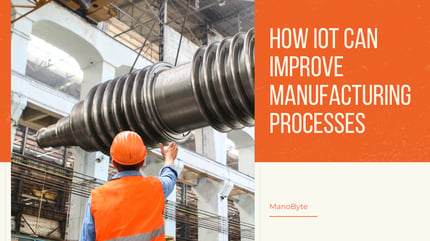
Many companies are making major investments in loT in order to increase business efficiency by extending human capabilities.
Real-time insights and predictive analytics have already started to help businesses grow their market shares and revenues faster than their competitors in different industries including manufacturing.
What is IoT?
loT and lloT are often used interchangeably, but both terms represent different aspects of technology that can be utilized in manufacturing.
- Internet of Things (IoT): A network of everyday devices, appliances, and other objects equipped with computer chips and sensors that can collect and transmit data through the Internet
- Industrial Internet of Things (IIoT): Interconnected sensors, instruments, and other devices networked together with computers’ industrial applications, including manufacturing and energy management
The goal behind IoT and IIoT is to create a completely automated system of devices that self-report in real-time, improving efficiency and bringing important information to the surface more quickly than human intervention could manage on its own.
4 Steps IoT Implementation
There is a four-step process to a successful loT implementation. While companies can do without these steps, they are recommended in order to increase productivity.
Step 1: Discovery
This first phase of an IoT project includes defining your project in several ways to make sure everyone involved understands the objectives and can approach problems from a comprehensive perspective.
Step 2: Configuration
The second step is where you create the infrastructure for the network and create a framework for the applications needed to fulfill the goals set.
Step 3: Continuous Improvement
Like many processes and programs within your company, loT should be continuously improved upon. As your company grows, new features may need to be added or improved upon. Additionally, companies may find loT needs to be adapted and changed to match a particular project.
Step 4: Evaluation
The last step goes hand in hand with step 3. It is important to evaluate if your goals are met, otherwise, corrective action needs to be taken. A loT should improve the quality of your business functions and data, not distort or discommode you.
Unlocking New Opportunities For Manufacturers
The most significant challenge in the manufacturing industry is to deliver high-quality products and services at economical costs in the shortest amount of time. IoT is creating new opportunities for companies to improve services, increase efficiency, minimize downtime, and reduce manufacturing costs. Using automated learning algorithms, IoT applications, and advanced analytics, manufacturers have access to more resources and assets, gain business insights from accurate and timely data, and enhance operational efficiencies and production performance. Effectively using these technologies helps companies to find new business models and derive new revenue streams.
Creating a New Era For Manufacturing
Implementing IoT is a part of the digital transformation journey in order to achieve manufacturing excellence. In order to realize the full potential of IoT, companies need to combine the collected data with rapidly advancing algorithms in order to generate value.
Ultimately, loT enables manufacturers to carry out many of the day-to-day operations with utmost certainty with little human intervention. loT has increased the capability of adapting to changing tasks and making recommendations based on accurate data.
Take Back Control of Outsourcing
Manufacturers often outsource to decrease costs. When production is outsourced, your company often sacrifices control. Quality control, assurance of supply, and sustainability can all become issues when it’s out of the hands of the original company.
IoT provides clearer transparency into your partners’ processes. Smart machines in smart factories are able to communicate their real-time statuses to a centralized hub that can verify production. Additionally, location and time-stamped data provide better visibility and control, in turn, increasing the accountability of your partners.
Minimize Unplanned Downtime
Factories are often rushed to react when machines stopped working or start performing poorly, which requires owners to rush repairs and try to get production back up to full capacity. Often this involved technicians interrupting factory workflow or working extra hours to troubleshoot and resolve mechanical issues. Additionally, if necessary parts are not in stock, companies are faced with unexpected costs, delayed production schedules, and missing deadlines.
loT allows companies to manage their production, and gain insight into projected productivity and potential downtime. Additionally, loT is able to pre-order parts before a machine requires downtime and can schedule regular maintenance to prevent lessened productivity.
Combining IoT and ERP For Better Opportunities
Quantity and Quality Data
Using loT allows ERPs to utilize valuable real-time data in projections and operational processes. By integrating IoT and ERP, companies can improve data availability, which can lead to operational excellence. The data accumulated due to IoT sensors will be directly fed to the ERP software. ERPs are able to alert leaders of any expected downtime, low stock, or recalls that will directly influence their business. Additionally, ERPs provide valuable financial data that can be used in expansion efforts and projection modeling.
Improved Interaction
There are many people involved in between the time a product is manufactured until the time it reaches the customers. With IoT all information will be automatically updated in the ERP system in real-time, helping every stakeholder to stay on the same page. ERP systems will automatically operationalize the endless influx of IoT data.
Business Intelligence
ERP, when combined with IoT data, helps organizations to gain vital business-related insights instantaneously. A continuous stream of data enables companies to carry out real-time analysis and projections, which helps them gain actionable insights to make tactical decisions that will increase revenue generation significantly.
By using IoT to improve the production process, manufacturers ultimately improve customer satisfaction through increased availability, higher quality products, and faster shipping times. With an IoT-enabled digital factory, manufacturers can provide a higher level of product and service to gain an edge over competing businesses. Contact one of our Business Growth Consultants today to see how we can help your business implement an ERP or market your pre-existing loT.

